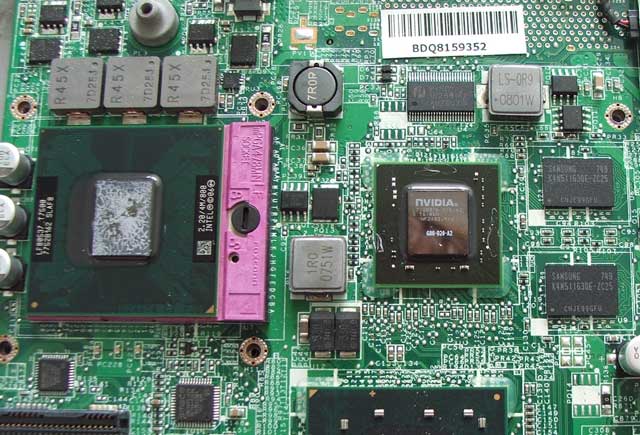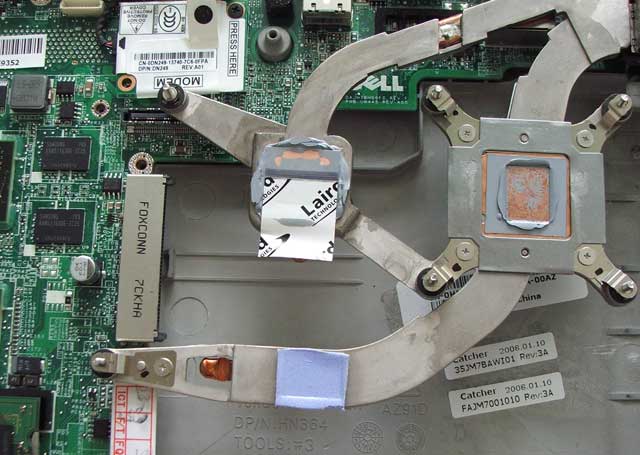Easter egg in my laptop. Rotten
A few years ago I purchased the Dell Latitude D830. In general, it’s a very solid machine, with a lot of advantages (the main one is an excellent 15.4 "matte 1680 × 1050 screen), but ... almost from the moment of purchase it was very confusing for the modest performance of its video system. However, since it was not bought for games, and for work, I didn’t bother much about this topic, especially since the video there on a rather exotic nVidia Quadro NVS140M (geared to CAD version of the GeForce 8400M) - there was no reliable information about how it should behave, it sinned nVidia drivers and chip specifics. you won’t play it - well, okay.
Recently it has become much worse. The video was terribly slow when viewed in full screen, and the cooling fan worked almost constantly. GPU-Z showed that the frequencies of the processor, shader units and memory under any load are 169/337 / 100MHz (from the standard 400/800/400) and the temperature of the video chip was 75 ° C idle and 85 ° C under load. The temperature indicators, frankly, did not shock me , because in the bins there is a desktop nVidia 8400GS with passive cooling - for her this is quite normal mode, there only at 125 ° C throttling is turned on. But here are the frequencies ...
I picked up a screwdriver.
Yes, those in the topic probably already guessed what I found in a business-class laptop. :)

Perfectly clean video chip. Not the slightest sign of thermal paste. And why?

Do not remove the protective sticker. The inscription on a piece of paper is Laird technologies (apparently, a manufacturer of thermal paste). To say that I was surprised is to say nothing. Thank you, “good” Chinese. For three whole years I,like a sucker, used a “warmed” video card, which worked 4 times slower than it should.
I tore off the sticker, cleaned the heatsinks of the processor and the video chip from hardened thermal paste, applied a thin layer of Alsil-3 to the chips, and assembled it. Result: 55 ° C idle, 65 ° C under load. The video flies, Aero flies, if you wish, you can even play Left 4 Dead (reducing quality, of course).
The moral of the story? If the technique behaves strangely - we are looking for a reason, without discarding the most incredible options. And regardless of the brand.
Recently it has become much worse. The video was terribly slow when viewed in full screen, and the cooling fan worked almost constantly. GPU-Z showed that the frequencies of the processor, shader units and memory under any load are 169/337 / 100MHz (from the standard 400/800/400) and the temperature of the video chip was 75 ° C idle and 85 ° C under load. The temperature indicators, frankly, did not shock me , because in the bins there is a desktop nVidia 8400GS with passive cooling - for her this is quite normal mode, there only at 125 ° C throttling is turned on. But here are the frequencies ...
I picked up a screwdriver.
Yes, those in the topic probably already guessed what I found in a business-class laptop. :)

Perfectly clean video chip. Not the slightest sign of thermal paste. And why?

Do not remove the protective sticker. The inscription on a piece of paper is Laird technologies (apparently, a manufacturer of thermal paste). To say that I was surprised is to say nothing. Thank you, “good” Chinese. For three whole years I,
I tore off the sticker, cleaned the heatsinks of the processor and the video chip from hardened thermal paste, applied a thin layer of Alsil-3 to the chips, and assembled it. Result: 55 ° C idle, 65 ° C under load. The video flies, Aero flies, if you wish, you can even play Left 4 Dead (reducing quality, of course).
The moral of the story? If the technique behaves strangely - we are looking for a reason, without discarding the most incredible options. And regardless of the brand.
